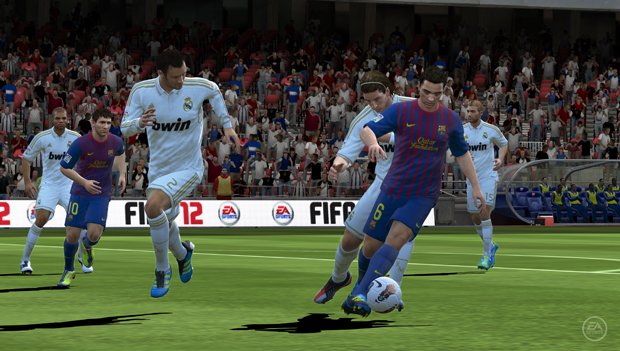Box Score: Taking the leap, Part 2
Turning a wish list into a working game, one frame at a time

Box Score is a weekly column that offers a look at sports games and the athletic side of the industry from the perspective of veteran reviewer and sports fan Richard Grisham.
This is the second of a 3-part series examining how FIFA for the Vita went from conception to completion. To read Part 1, click here.
Seeing stick figures running around on a barren landscape doesn’t sound like much to you and me. To Matt Prior, though, it was the first real breakthrough he had since his team had set out to create a FIFA experience on the all-new PlayStation Vita.
“A lot of people think FIFA just kind of appears on the screen,” laughs Prior. “You don’t just copy and paste it over from the PS3 to the Vita. If only you could! The hardware is very different. To get FIFA – a game that pushes the PS3 to its limits – working on the Vita isn’t an easy task; it took some of our finest minds.”
Prior had already been through a grueling process to assemble a team and craft a vision for the debut of the hugely popular soccer franchise on Sony’s new handheld. All the while, he had to wait for the system engineers to get the basic building blocks of the game working on the initial Vita development kits; fundamental engine, rendering, and mechanical systems needed to be linked together and compiled.
Then, it happened.

“The first ‘a-ha!’ moment was just seeing something running on the Vita,” Prior says. “From a gamer’s standpoint, you’d be very unimpressed with what we first saw. It’s like stick figures running around this kind of stick environment at three frames a second; it wouldn’t impress anyone from a gaming standpoint.”
Sign up to the GamesRadar+ Newsletter
Weekly digests, tales from the communities you love, and more
To Prior, though, it was the first validation that his vision would become a real product. “This is actually going to work,” he recalls thinking upon first laying his eyes and hands on that initial build. “We’ve finally gotten things in; this is going to happen.”
It’s a slow, methodical journey to turn those first snippets of a game into something a person can actually manipulate, even in a simplistic state – particularly when you’re putting it together on a platform no one’s ever used. Every day, the team would make the adjustments, build the code, and, over time, release updated versions for Prior and company to work out.

“The second [‘a-ha!’ moment] was getting the gameplay actually to a playable state,” continues Prior. “From those stick figures, it goes through a very gradual, iterative process; you get the players rendering, then you get the pitch rendering, then you get the stadium rendering. It all kind of comes together gradually.”
The ever-important framerate is constantly tweaked along the way as well. “Framerate as you see it now is a super-smooth, beautiful 30 frames per second,” he says – but getting to 30 from 3 is an intricate process that takes lots of time and effort. “It literally goes in frame-to-frame increments, build to build.”
Prior’s goal – pun intended – for his FIFA was to capitalize on the unique features that the Vita offers. So once the basics of gameplay were in place, the team could get to work on building a title that would set itself apart from its predecessors.
“We needed a lot of prototyping,” Prior recalls. “You need a game working in your hands to get a feel of what would work and what wouldn’t work. Once we got the game to a playable state, we could start prototyping the new features.”
Those features, of course, utilize the front and rear touchscreens. The team knew it wanted to use them to change the way players pass and shoot, and set out to implement the systems. Over time, prototypes turned into builds, and one particular day, Prior’s vision was translated into reality.

“I remember quite vividly the first time I scored what I call a ‘complete touchscreen’ goal,” Prior described. “From the goalkeeper, I passed it out all the way down the field using the touchscreen, then using the rear touch, kind of picked my spot in the top-right-hand corner. I scored a goal completely crafted with the touch screen, which uses all our new features. So the biggest ‘a-ha!’ moment for me was when we implemented the touch screen, tuned it, and then we could actually play it.”
Not only was it rewarding because of the mechanics of pulling it off, but because there was finally the validation that his plans – pitched and honed from executive boardrooms to designer whiteboards to programming documents – had become tangible.
“The level of reward and satisfaction that gave me (was huge),” Prior concludes. “You’re no longer at the mercy of the AI. The AI’s not pulling the strings anymore – I can pass to any pixel point on the pitch and likewise shoot at any point in the goal, which, on previous FIFAs, has never really allowed that level of accuracy.”
In one sense, the hardest parts were behind Prior and the FIFA team. In another sense, however, they were just getting started.
NEXT WEEK: Putting FIFA – and the Vita - in the hands of gamers for the first time.
Richard Grisham has been obesessed with sports and video games since childhood, when he'd routinely create and track MicroLeague Baseball seasons on paper. He currently lives in New Jersey with his wife and four-year old son, who he'll soon be training to be an NFL placekicker. As a freelance journalist and writer, his work has appeared in GamesRadar, NGamer, and 1UP.


